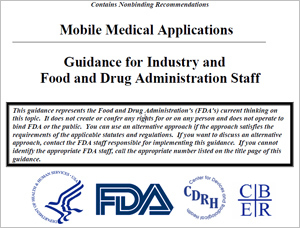What Does the FDA Mean by 'Guidance'? What Does the FDA Mean by 'Guidance'?
What Does the FDA Mean by 'Guidance'? On September 23, 2013, the U.S. Food and Drug Administration (FDA) issued the long awaited final guidance (Guidance) on mobile medical apps.The document notes that it "Contains Nonbinding Recommendations" and that it merely provides "guidance". Specifically, the FDA explains: This guidance represents the Food and Drug Administration's (FDA's) current thinking on this topic. It does not create or confer any rights for or on any person and does not operate to bind FDA or the public. You can use an alternative approach if the approach satisfies the requirements of the applicable statutes and regulations...FDA's guidance documents, including this guidance, do not establish legally enforceable responsibilities. Instead, guidances describe the Agency's current thinking on a topic and should be viewed only as recommendations, unless specific regulatory or statutory requirements are cited. The use of the word should in Agency guidances means that something is suggested or recommended, but not required.
| 
|
But, guidance documents are important because the FDA tends to follow its own guidance (but not always).
What is the difference between laws, regulations, and guidance documents?
The FDA must follow a set of laws, which are passed by Congress, and the FDA routinely issues regulations and guidance documents.
Laws
One of the primary laws establishing the framework within which the FDA operates is the Federal Food, Drug, and Cosmetic Act (FD&C Act) (reference edition available from the FDA here). The FD&C Act is amended by Congress from time to time. Some of the more significant amendments include the Orphan Drug Act of 1983, Food Quality Protection Act of 1996, the FDA Food Safety Modernization Act of 2011, and others. (List of significant FD&C Act amendments.)
Regulations
The FDA develops regulations based on the laws that are set forth in the FD&C Act as well as the other laws under which the FDA operates. Regulations issued by the FDA are federal laws and are codified in the Code of Federal Regulations.
In issuing regulations, the FDA follows the procedures set forth in the Administrative Procedure Act (APA). Broadly speaking, the APA sets for a Notice and Comment Rule Making process, which requires that regulatory agencies issue a proposed regulation, allow time for public input, and then issue a final regulation. More information about this process is available here (PDF, Federal Register FAQ), here (Center for Effective Government), and here (LSU Public Health Map).
Guidance Documents
After a regulation is issued, the FDA may determine that it needs to provide stakeholders with more information on how the FDA intends to exert (or decline to exercise, as the case may be) its regulatory authority. The FDA does this through issuing Guidance documents. The FDA follows the procedures required by its "Good Guidance Practice" regulation to issue FDA guidance. FDA guidance describes the agency’s current thinking on a regulatory issue.
Guidance documents must not set new legal standards or impose new requirements. Unlike regulations, guidance documents do not contain amendments to the Code of Federal Regulations and are not subject to the notice and comment process.
Are FDA Guidance Document Law?
No. As the FDA makes clear, the FDA guidance documents are not legally binding on the public or the FDA. BUT, the FDA has come to rely on guidance documents as a means of informal policy making. By telling industries when it does and does not plan to act, the FDA is giving industry stakeholders notice of its position on certain issues (e.g., how the FDA intends to treat mobile medical apps). As a result, impacted industries would be wise to take heed and pay attention to the guidance documents. So, for practical purposes, FDA guidance documents are laws.For more on the FDA and why it issues guidance documents, please see the following law review articles:
|
January 2026
| Su | Mo | Tu | We | Th | Fr | Sa |
| | | | 1 | 2 | 3 |
| 4 | 5 | 6 | 7 | 8 | 9 | 10 |
| 11 | 12 | 13 | 14 | 15 | 16 | 17 |
| 18 | 19 | 20 | 21 | 22 | 23 | 24 |
| 25 | 26 | 27 | 28 | 29 | 30 | 31 |
|
Blog Home

Newest Blog Entries
7/23/15 Hospital Settles with OCR for $ 218,400 Over Cloud-Based File Sharing
6/8/15 Two California Privacy Bills to Watch in 2015
3/28/15 When Looking at Security, Consider Every Device
3/9/15 Alabama Board of Optometry Makes Final a Rule on Telemedicine
1/25/15 Indiana Court of Appeals Upholds $1.44 Million Jury Verdict Against Walgreen Co. in a Privacy Breach Case; Denies Rehearing
12/9/14 Malware Leads to a $150,000 OCR Settlement with a Behavioral Health Provider
11/30/14 Can a Board of Medicine Use the State’s Prescription Drug Database in Investigating Physician Actions?
11/29/14 Under the Florida Telemedicine Rule, Can a Physical be Conducted by Telemedicine?
11/19/14 Wearables and the Challenge for Consumer Device Makers
10/28/14 A Few Telemedicine Resources
10/27/14 FCC: The Newest Regulator to Throw its Hat into the Data Privacy and Security Ring
Blog Archives
November 2014 (3)
December 2014 (1)
August 2014 (4)
November 2013 (3)
October 2013 (9)
January 2014 (4)
March 2014 (3)
October 2014 (2)
February 2014 (4)
January 2015 (1)
July 2014 (1)
September 2014 (1)
May 2014 (6)
December 2013 (5)
July 2015 (1)
June 2015 (1)
April 2014 (6)
June 2014 (3)
March 2015 (2)
Blog Labels
Identity Theft (1)
FAQ (6)
EHR (2)
FCC (1)
Big Data (3)
Medical Marijuana (1)
Dental (1)
Financial Services (1)
Social Media (2)
Meaningful Use (4)
Privacy (4)
Privacy Litigation (3)
Marketing (1)
Employment (1)
Data Breach (10)
Healthcare Fraud (1)
Mobile Apps (2)
Telemedicine (7)
Healthcare Competition (1)
HIPAA (3)
Mobile Apps FDA (2)
Security (1)
BYOD (2)
|

